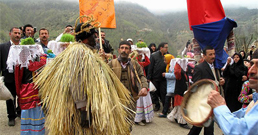Since very ancient times, it is said, the Arous Gol ceremony has been held around Gilan and Mazandaran, two Caspian Sea provinces of Iran. The ceremony is part of festivities just before 21 March and a reminder of the arrival of spring.
Locals spend an afternoon in celebration, with much whooping with joy, dancing, clapping and laughter. After gathering people by singing and dancing around the neighbourhood from the early afternoon, the centrepiece of the day’s events is a performance acted in public. It recounts the story of Pir Baba fighting with the black ogre over Arous Gol, and ends with them dancing their victory around the ogre. Young girls holding herbs, lamps, flowers and sweets signifying blessings, fertility, light and sweetness follow them around.
There are symbols of the spring season and of a renewal of agriculture in the ceremonies, reminding audiences of the nearing of spring. As a pre-Islamic event, it offers a glimpse of the distant past, and a rare insight into its emotions and sense of community.
This multimedia report takes us to the village of Masouleh, in northern Iran, and shows us the sights and sounds of this old ritual as expressed in the present day.


